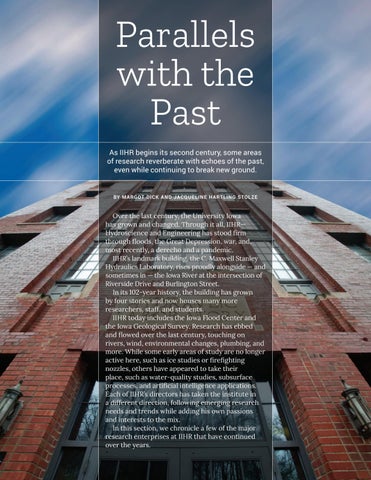Parallels with the Past As IIHR begins its second century, some areas of research reverberate with echoes of the past, even while continuing to break new ground.
BY MA RG OT DI C K A N D JA CQU E L I N E H A RT L I N G S TO L Z E
Over the last century, the University Iowa has grown and changed. Through it all, IIHR— Hydroscience and Engineering has stood firm through floods, the Great Depression, war, and, most recently, a derecho and a pandemic. IIHR’s landmark building, the C. Maxwell Stanley Hydraulics Laboratory, rises proudly alongside — and sometimes in — the Iowa River at the intersection of Riverside Drive and Burlington Street. In its 102-year history, the building has grown by four stories and now houses many more researchers, staff, and students. IIHR today includes the Iowa Flood Center and the Iowa Geological Survey. Research has ebbed and flowed over the last century, touching on rivers, wind, environmental changes, plumbing, and more. While some early areas of study are no longer active here, such as ice studies or firefighting nozzles, others have appeared to take their place, such as water-quality studies, subsurface processes, and artificial intelligence applications. Each of IIHR’s directors has taken the institute in a different direction, following emerging research needs and trends while adding his own passions and interests to the mix. In this section, we chronicle a few of the major research enterprises at IIHR that have continued over the years. 8 • IIHR CUR R ENTS 2021–22






